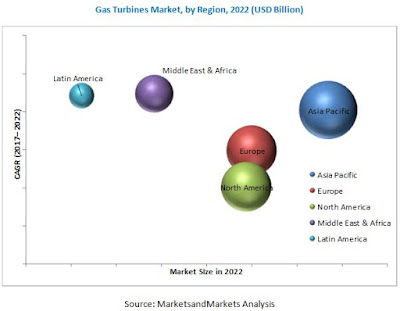According to the new market research report "Gas Turbines Market by Technology (Open Cycle and Combined Cycle), Rating Capacity (Less than 40 MW, 40-120 MW, 120-300 MW, and Above 300 MW), Design Type (Heavy Duty and Aeroderivative), Application (Power and Oil & Gas), and Region - Global Forecast to 2022", published by MarketsandMarkets™, The gas turbines market is expected to reach USD 19.6 billion by 2020, at a CAGR of 3.9% during the forecast period. Increasing demand for electric power worldwide and subsequent investments in creating new generating capacity is driving the gas turbines market across the world. The shale gas boom in North America and decommissioning of nuclear plants in Europe are likely to boost the demand for gas turbines in these two regions. Meanwhile, the demand for gas turbines in the Middle East & Africa, Latin America, and Asia-Pacific would be influenced by the upcoming new gas-fired power plants as well as the upgrade of old existing thermal power plants.
The combined cycle power plants segment was the largest market and is estimated to account more than two-thirds of the total market. Combined cycle power plants are similar to open cycle power plants, except, in combined cycle plants, the waste heat from gas turbines is used to make steam to produce additional electricity using steam turbines. The initial costs for installation and the investments required till the commissioning of combined cycle power plants are high. Combined cycle power plants help lower the total emissions since the exhaust is utilized for other operations.
The report segments the gas turbines market, on the basis of application, into power generation, oil & gas, and other industrial applications. The power generation segment is expected to grow at the fastest rate during the forecast period. An increase is expected in the demand for combined cycle power plants as they offer low carbon dioxide emissions and higher efficiencies. In the oil & gas application, gas turbines are used to pump natural gas through pipelines where a small part of the pumped gas serves as the fuel. Industrial gas turbines range from 1,000 to 50,000 HP, with a majority installed in the oil & gas industry. Other industrial applications use gas turbines to run compressors or mechanical drives, which help in various industrial processes.
Asia-Pacific: The largest market for gas turbines
The Asia-Pacific region is currently the largest market for gas turbines, followed by Europe and North America. Japan accounted for a majority share in Asia-Pacific in 2014, while China is projected to grow at the highest CAGR from 2015 to 2020. The slowdown in the nuclear power industry due to the Fukushima incident and continuing replacement of nuclear & aging coal plants with gas-fired ones would continue to drive the Japanese gas turbines market. In developing countries such as China and India, factors such as strong growth in demand for electricity fueled by high levels of urbanization, industrialization, & infrastructural developments and subsequent investments in developing new large-gas fired combined cycle power generation, apart from other power plants, would spur the demand for gas turbines.
Download PDF Brochure @ https://www.marketsandmarkets.com/pdfdownloadNew.asp?id=94641697
Some of the key players operating in the gas turbines market include General Electric Company (U.S.), Siemens AG (Germany), Mitsubishi Hitachi Power Systems, Ltd. (Japan), and Alstom S.A. (France) among others.
The combined cycle power plants segment was the largest market and is estimated to account more than two-thirds of the total market. Combined cycle power plants are similar to open cycle power plants, except, in combined cycle plants, the waste heat from gas turbines is used to make steam to produce additional electricity using steam turbines. The initial costs for installation and the investments required till the commissioning of combined cycle power plants are high. Combined cycle power plants help lower the total emissions since the exhaust is utilized for other operations.
The report segments the gas turbines market, on the basis of application, into power generation, oil & gas, and other industrial applications. The power generation segment is expected to grow at the fastest rate during the forecast period. An increase is expected in the demand for combined cycle power plants as they offer low carbon dioxide emissions and higher efficiencies. In the oil & gas application, gas turbines are used to pump natural gas through pipelines where a small part of the pumped gas serves as the fuel. Industrial gas turbines range from 1,000 to 50,000 HP, with a majority installed in the oil & gas industry. Other industrial applications use gas turbines to run compressors or mechanical drives, which help in various industrial processes.
Asia-Pacific: The largest market for gas turbines
The Asia-Pacific region is currently the largest market for gas turbines, followed by Europe and North America. Japan accounted for a majority share in Asia-Pacific in 2014, while China is projected to grow at the highest CAGR from 2015 to 2020. The slowdown in the nuclear power industry due to the Fukushima incident and continuing replacement of nuclear & aging coal plants with gas-fired ones would continue to drive the Japanese gas turbines market. In developing countries such as China and India, factors such as strong growth in demand for electricity fueled by high levels of urbanization, industrialization, & infrastructural developments and subsequent investments in developing new large-gas fired combined cycle power generation, apart from other power plants, would spur the demand for gas turbines.
Download PDF Brochure @ https://www.marketsandmarkets.com/pdfdownloadNew.asp?id=94641697
Some of the key players operating in the gas turbines market include General Electric Company (U.S.), Siemens AG (Germany), Mitsubishi Hitachi Power Systems, Ltd. (Japan), and Alstom S.A. (France) among others.

No comments:
Post a Comment